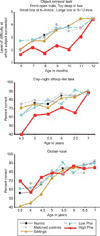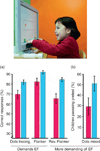Biological and social influences on cognitive control processes dependent on prefrontal cortex
- PMID: 21489397
- PMCID: PMC4103914
- DOI: 10.1016/B978-0-444-53884-0.00032-4
Biological and social influences on cognitive control processes dependent on prefrontal cortex
Abstract
Cognitive control functions ("executive functions" [EFs] such as attentional control, self-regulation, working memory, and inhibition) that depend on prefrontal cortex (PFC) are critical for success in school and in life. Many children begin school lacking needed EF skills. Disturbances in EFs occur in many mental health disorders, such as ADHD and depression. This chapter addresses modulation of EFs by biology (genes and neurochemistry) and the environment (including school programs) with implications for clinical disorders and for education. Unusual properties of the prefrontal dopamine system contribute to PFC's vulnerability to environmental and genetic variations that have little effect elsewhere. EFs depend on a late-maturing brain region (PFC), yet they can be improved even in infants and preschoolers, without specialists or fancy equipment. Research shows that activities often squeezed out of school curricula (play, physical education, and the arts) rather than detracting from academic achievement help improve EFs and enhance academic outcomes. Such practices may also head off problems before they lead to diagnoses of EF impairments, including ADHD. Many issues are not simply education issues or health issues; they are both.
Copyright © 2011 Elsevier B.V. All rights reserved.
Figures






References
-
- American Psychiatric Association. Diagnostic and Statistical Manual of Mental Disorders. 4th ed. Washington, DC: American Psychiatric Association; 1994.
-
- Arnsten AF, Cai JX, Murphy BL, Goldman-Rakic PS. Dopamine D1 receptor mechanisms in the cognitive performance of young adult and aged monkeys. Psychopharmacology. 1994;116:143–151. - PubMed
-
- Arnsten AF, Goldman-Rakic PS. Noise stress impairs prefrontal cortical cognitive function in monkeys: Evidence for a hyperdopaminergic mechanism. Archives of General Psychiatry. 1998;55:362–368. - PubMed
-
- Auerbach JG, Benjamin J, Faroy M, Geller V, Ebstein R. DRD4 related to infant attention and information processing: A developmental link to ADHD? Psychiatric Genetics. 2001;11:31–35. - PubMed
-
- Bannon MJ, Bunney EB, Roth RH. Mesocortical dopamine neurons: Rapid transmitter turnover compared to other brain catecholamine systems. Brain Research. 1981;218:376–382. - PubMed
Publication types
MeSH terms
Substances
Grants and funding
LinkOut - more resources
Full Text Sources
Miscellaneous

